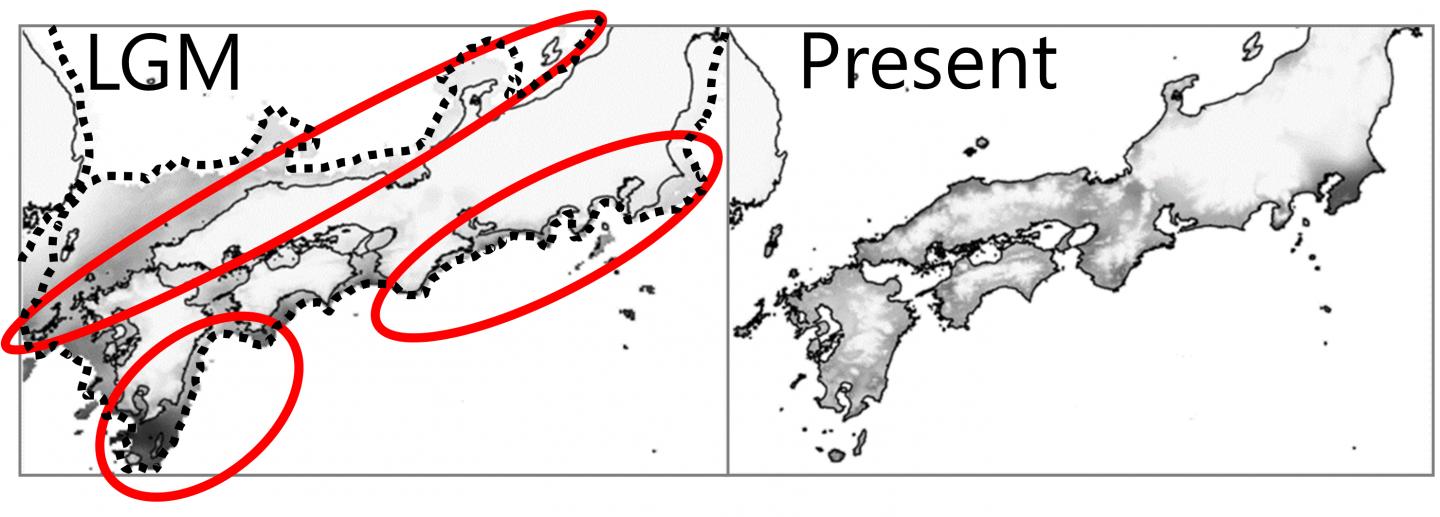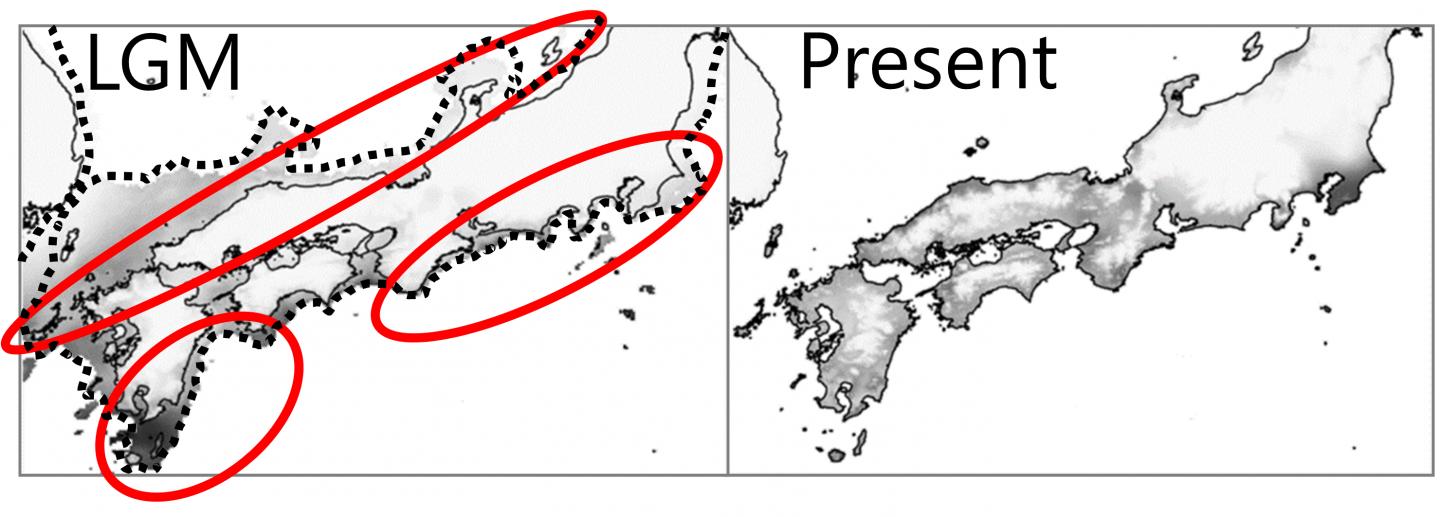
Credit: ©2018 Forestry and Forest Products Research Institute, Osaka University, and Gifu Academy of Forest Science and Culture
Japanese researchers investigated whether a dominant tree of warm temperate broadleaved forests in Japan, Castanopsis sieboldii, underwent northward migration over hundreds of kilometres from Last Glacial Maximum (LGM) (about 21,000 years ago) refugia in the Ryukyu archipelago and southern Kyushu, where fossil pollen indicates the LGM survival of broadleaved evergreen forests, or was in fact able to survive closer to its present range in colder areas such as the coast of the Japan Sea and the Pacific Ocean side of eastern Honshu during the Last Glacial Maximum (LGM). Using a combined genetic analysis and modelling approach, it was found that the East Japan populations, where few pollen fossil records exist, survived in situ during the LGM on both the Japan Sea and Pacific coasts and were not established via expansion after the LGM from southern areas. Their findings were published online in Heredity.
The climate of the earth about 21,000 to 18,000 years ago during the LGM was particularly cold, with average temperatures 5 to 7 ℃ lower than the present-day. From the excavation of fossil pollen and plant bodies, it is believed that broadleaved evergreen forests were driven to warmer areas in the Ryukyu Archipelago and southern Kyushu during the LGM. After the LGM, they expanded their distribution northward to the Japan Sea and the Pacific coast. There has been a debate on whether the broadleaved evergreen forests, which presently occupy wide areas in warm temperate regions of Japan, had expanded from a limited area in the southern part of Kyushu, or survived in small forests in various areas in Japan. Using a species distribution modelling approach to model the species' LGM distribution, a suitable climate is predicted in the southern part of the Pacific coast (Fig. 1), which is further supported by genetic evidence.
In the study, researchers investigated where C. sieboldii, a dominant tree species of broadleaved evergreen forests in Japan, inhabited during the glacial period by constructing multiple models based on genetic diversity. The result indicated that the Ryukyu and the West Group existed from the oldest period, and that the East and the Japan Sea Group were formed from the West Group (Figure 2). Furthermore, the estimated time of diversification suggested that these four groups had already been established before the LGM. The result suggested that C. sieboldii survived separately in Ryukyu, West, Japan Sea, East during the LGM, and expanded the population as it became warmer during the past-glacial.
This study identified major genetic lineages in the broadleaved evergreen tree species C. sieboldii in the Ryukyu Archipelago, Western Japan, the Japan Sea, and Eastern Japan. The unique genetic composition of each region has formed as a result of a long history of genetic isolation associated with the glacial-interglacial cycles.
In recent years, the importance of preserving local genetic diversity has been recognized. When planting broadleaved trees to assist natural regeneration or during afforestation, it is necessary not to disturb the local genetic diversity as much as possible.
Lead author Kyoko Aoki at Osaka University says, "Our research highlights the importance of restricting the distribution of seedlings across the genetic boundaries identified between Ryukyu, Western Japan, Japan Sea, and Eastern Japan in order to retain genetic patterns which have formed over thousands of years."
###
This study was performed in collaboration with Forestry and Forest Products Research Institute, Osaka University, Gifu Academy of Forest Science and Culture, University of Tsukuba, Kyoto University, and Tokyo Metropolitan University.
About Osaka University
Osaka University was founded in 1931 as one of the seven imperial universities of Japan and now has expanded to one of Japan's leading comprehensive universities. The University has now embarked on open research revolution from a position as Japan's most innovative university and among the most innovative institutions in the world according to Reuters 2015 Top 100 Innovative Universities and the Nature Index Innovation 2017. The university's ability to innovate from the stage of fundamental research through the creation of useful technology with economic impact stems from its broad disciplinary spectrum.
Website: http://resou.osaka-u.ac.jp/en/top
Media Contact
Saori Obayashi
[email protected]
81-661-055-886
@osaka_univ_e
http://www.osaka-u.ac.jp/en
Original Source
https://resou.osaka-u.ac.jp/en/research/2018/20180928_1 http://dx.doi.org/10.1038/s41437-018-0123-9





